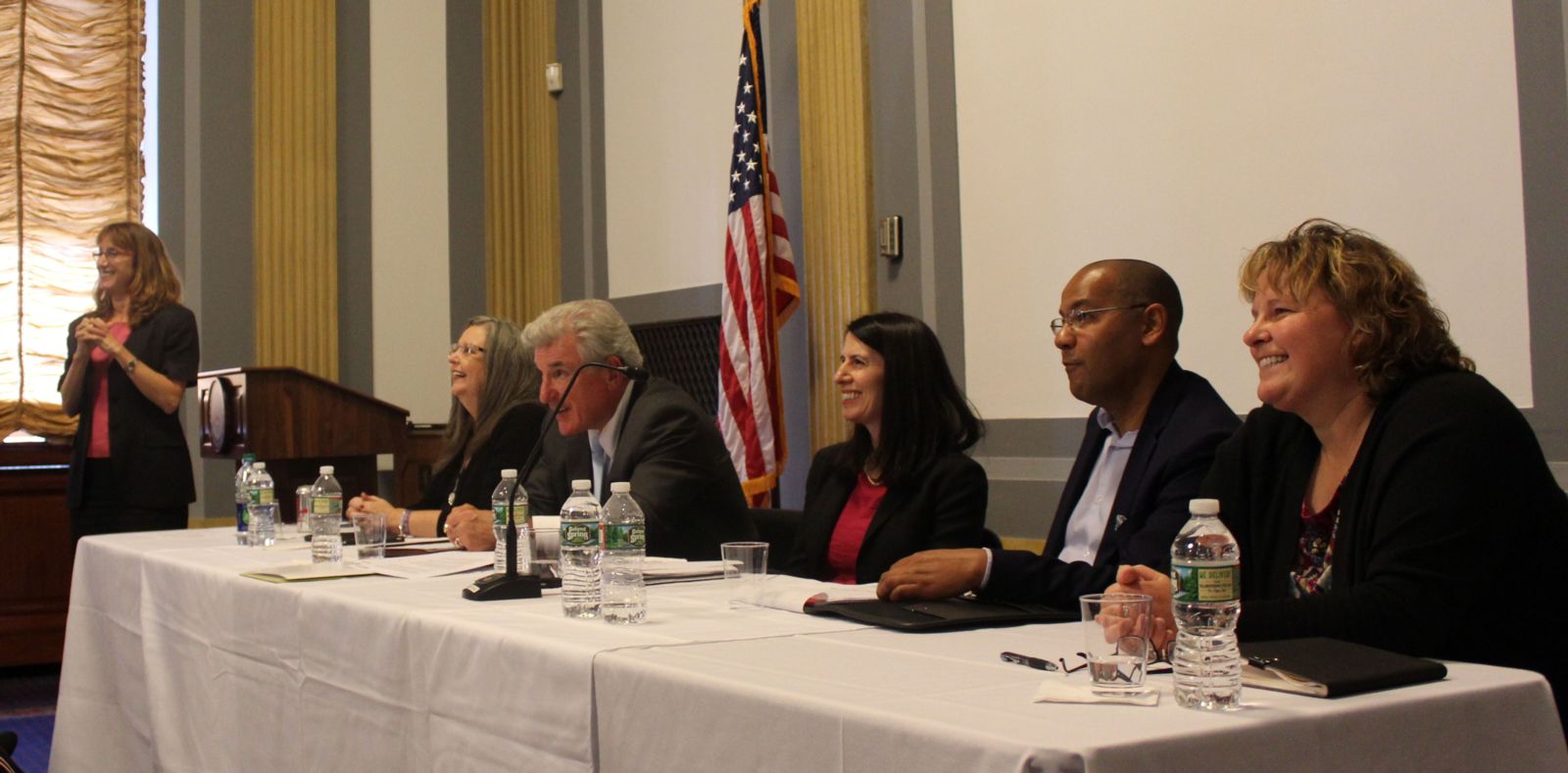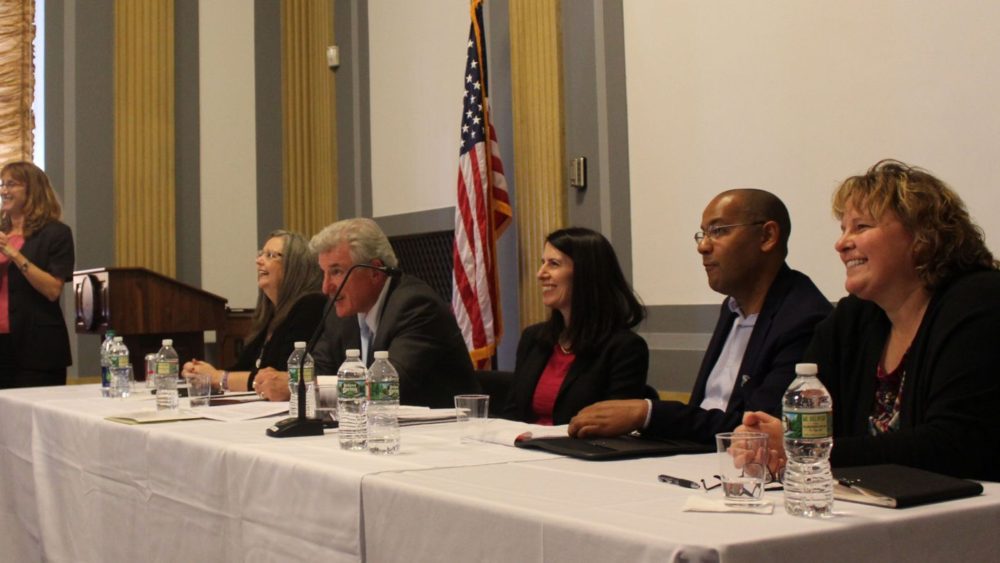 |
On September 12, 2017 the Senate Afterschool Caucus led by Senators Murkowski (R-Alaska) and Franken (D-Minn.) hosted a “Back to Afterschool” briefing highlighting a diverse panel of experts from the military, health, education, government, and philanthropic sectors. Each speaker attested to the value of afterschool and summer programs from their unique vantage point and the need for a combination of federal, state, and local support.
Afterschool Alliance Executive Director Jodi Grant opened the panel by noting that the research on the positive impacts of afterschool programs is clear, and programs across the country are making a huge difference for students and families.
“The effectiveness of high quality afterschool and summer programs,” Grant stated, “should not be in question. Support for these programs runs wide and deep.”
From the office of the mayor
Karen Best, currently serving her second term as mayor of Branson, Missouri, explained to the audience that Branson is a town of seasonal work. Many families are in the entertainment industry often needing to work three shifts in the busy season to make ends meet. And it’s not only parents and the economy who benefit. Referencing author and academic Ruby Payne, Mayor Best reminded the audience that children require both education and relationships — two components strongly present in afterschool programs.
Mayor Best shared a story of a student who she’d watched transition from an anxious wallflower to a leader in a local Boys and Girls Club, concluding, “If you’re cutting funding for these programs, you are cutting the future for these kids.”
A salute to afterschool
Brigadier General (Ret.) Dave McGinnis, spoke next. B.G. McGinnis is a member of Mission Readiness, a project bringing together retired generals and admirals in an effort to keep American children academically and physically ready to serve the nation in any capacity they may choose. Yet today, many students are not ready.
The three barriers to qualification are ability to pass military readiness tests, obesity, and/or a history of police involvement or drug abuse — issues afterschool is prepared to tackle. Additionally, the military needs strategic thinkers.
“We are entering the age of the strategic corporal,” McGinnis related. “We’ve got to enlist people who can learn on their own, who can collaborate and create. They learn all those traits outside of the classroom.”
McGinnis appealed to the audience, “If there is ever a question about how important afterschool programs are, just look across the street at the Pentagon.”
Business is booming
Heather Nesle, President of the New York Life Foundation, explained New York Life’s investment in afterschool and summer program. After a survey of partners in the field to identify how best to support education, they heard afterschool and out-of-school time programs were “pivotal” in helping youth reach long term-success.
As part of the foundation’s work, the New York Life Foundation began a grant program, AIM High, to help successful local afterschool programs expand. Nesle reported that the 18 available grants received more than 470 applicants. “The demand is out there,” she said. “These are programs that work and they have long waiting lists to join.”
In addition to fostering academic achievement and community-building, Nesle highlighted afterschool programs as good for business, giving employees peace of mind about their children after the school day. Additionally, afterschool and summer programs help develop the next generation of a qualified and diverse workforce, by teaching kids to work in teams, get along with others, and tackle challenges.
Rx: afterschool
Randy Neve, manager at the Marshfield Clinic Center for Community Outreach in Wisconsin, gave three reasons why his organization invests in afterschool: programs reduce the incidence of teenage pregnancy, provide venues for coordinating delivery of services to youth and establishing preventative services, and improve students’ educational outcomes (which are directly correlated with health outcomes).
Marshfield Clinic’s initial program began through a grant to reduce teenage pregnancy. The clinic created Youth Net, an afterschool program which quickly became popular and filled to serving 300 youth a day. Today, the clinic works with AmeriCorp Volunteers and YMCAs to implement evidence-based practices and with pediatricians so youth at risk of obesity can be referred to a local afterschool program as part of a prescription for a healthy lifestyle. The clinic is also working to bring in mental health professionals who can help with well-child checks and work with youth who have experienced incidents of trauma.
Neve also mentioned his clinic provides leadership for one of 50 national Statewide Afterschool Networks, which focus on training and technical assistance to ensure all afterschool programs in the state are high-quality.
Stability for students
Anne Tanner, K-2 Principal at Arlee Elementary School on the Flathead Indian Reservation in Arlee Montana, shared moving stories about the struggles her district faces. Ninety-five percent of the youth in Arlee’s school district are eligible for Free and Reduced Meals (FARMS), while 30 percent of her elementary students are considered homeless and one in five of her second graders live in a foster home. The area has recently seen a surge of suicides, including the tragic death of a seventh grade student the night before Anne came to D.C.
School can often be the only constant for these children, Tanner explained. “We are in triage, we can’t do it without afterschool funding.” She continued mentioning her 21st Century Community Learning Center grant, calling it “the cornerstone for providing the help we know we need to give to our students.”
Tanner has been working creatively to extend the grant, which can only reach 50 percent of her student population. She has revamped her programs to include certified health professionals, a three-to-one ratio for students with a certified teacher, a focus on parent involvement, and engaging activities like science, technology, engineering and math (STEM), Discover Camp, and Leadership Camps.
Final thoughts: Why federal investment?
The panel concluded with a question from the audience asking if, in light of the inconsistency of federal funding, it would be better for programs to focus on private investment?
Panelists agreed that it was essential to involve the community and communicate about these program and what they do, but that local funding alone would not be enough to meet demand.
“It’s got to be a true partnership,” B.G. McGinnis explained. “This benefits everybody; it is not a charity program.”
The briefing involved the support of many partners including After-School All-Stars, American Camp Association, Boys and Girls Clubs of America, Communities in Schools, Council for a Strong America, Every Hour Counts, National Afterschool Association, National League of Cities, National Park and Recreation Association, National Summer Learning Association, Save the Children, and YMCA of the USA.

Comments are closed.